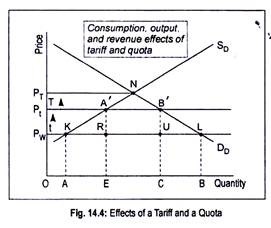This article will help you to compare between tariff and quota.
Governments of different countries have to intervene in the area of international trade for both economic and non-economic reasons. Such intervention goes by the name of protection.
Protection means government policy of according protection to the domestic industries against foreign competition. There are various instruments or methods of protection which aim at raising exports or reducing imports. Here we are concerned with those methods that restrict import.
There are various methods of protection.
ADVERTISEMENTS:
The most important methods of protection are:
Tariff and quota. A tariff is a tax on imports.
It is normally imposed by the government on the imports of a particular commodity. On the other hand, a quota is a quantity limit. It restricts imports of commodities physically. It specifies the maximum amount that can be imported during a given time period.
We can now make a comparison between tariffs and quotas in terms of partial equilibrium or demand-supply approach. The Fig. 14.4 illustrates the effects of tariffs. The domestic supply curve is represented by the SD curve while the demand curve is given by the DD curve. These two curves intersect each other at point ‘N’.
And the price that is determined is known as the autarkic price or pre-trade price (PT). If trade is free, the international price that would prevail is assumed to be PW. At the international price PW, a country produces OA but consumes OB and the country, therefore, imports AB.
Now, if a country imposes a tariff = t per unit on its import (small-arrow), immediately the price of the product will rise to Pt by the amount of tariff. This increase in price has the following effects.
Since the tariff raises the price, consumers buy less. Now the consumption declines from OB to OC. This is called the consumption effect of tariff. The second effect is the output effect or protective effect. Tariff raises domestic output from OA to OE, this is because higher price induces producers to produce more.
The third, effect is import-reducing effect—as tariff is imposed or tariff rate is increased import declines from AB to EC. The fourth effect is the revenue effect earned by the government. The government revenue is the volume of import multiplied by the tariff, i.e., the area A’B’UR.
ADVERTISEMENTS:
It is a transfer from the consumers to the government. However, if a tariff equal to T were imposed, the price would have increased to PT. Consequently, imports would drop to zero. Such a situation is called prohibitive tariff (big-sized arrow).
